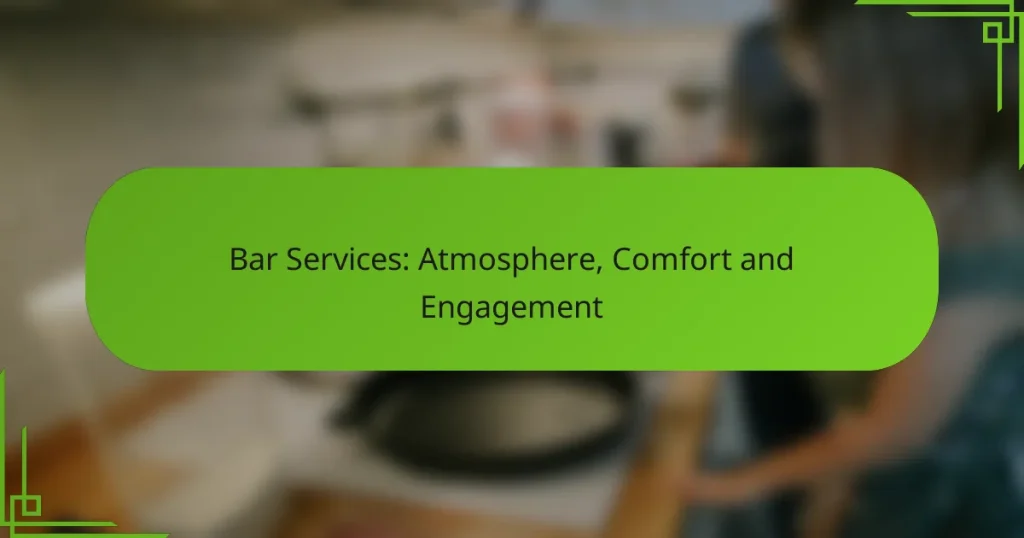Exceptional customer experience is vital for fostering loyalty and enhancing brand perception. By understanding customer needs and implementing strategies such as personalized communication and timely service delivery, businesses can create meaningful interactions. Emphasizing responsiveness, empathy, and consistency further enriches the customer journey, ensuring satisfaction and long-term engagement.
Bar Services: Complaint Resolution, Strategies and Satisfaction
Cocktails: Preferences, Trends and Customization
Bar Services: Evaluation, Standards and Quality
Staff Training: Techniques, Service Quality and Customer Focus
Bartenders: Skills, Interaction and Experience
Bar Services: Atmosphere, Comfort and Engagement
How to Enhance Customer Experience in Local Services?
Enhancing customer experience in local services involves understanding customer needs and delivering tailored solutions. Key strategies include personalized communication, timely service delivery, effective feedback mechanisms, and comprehensive staff training programs.
Personalized Communication
Personalized communication is crucial for building strong relationships with customers. Tailoring messages based on customer preferences and past interactions can significantly improve engagement and satisfaction.
Utilize customer data to segment your audience and create targeted messages. For example, sending personalized offers or reminders can make customers feel valued and understood.
Timely Service Delivery
Timely service delivery is essential for a positive customer experience. Customers expect services to be delivered promptly, and delays can lead to frustration and dissatisfaction.
Establish clear timelines for service delivery and communicate these to customers. Implementing efficient scheduling systems can help ensure that services are provided within expected timeframes, enhancing overall satisfaction.
Feedback Mechanisms
Effective feedback mechanisms allow customers to share their experiences and suggestions. This input is invaluable for identifying areas for improvement and enhancing service quality.
Consider using surveys, comment cards, or online reviews to gather feedback. Regularly review this information to make informed adjustments to your services, demonstrating to customers that their opinions matter.
Staff Training Programs
Investing in staff training programs is vital for delivering exceptional customer service. Well-trained employees are more equipped to meet customer needs and handle inquiries effectively.
Focus on training that emphasizes communication skills, problem-solving, and product knowledge. Regular workshops and role-playing scenarios can help staff practice and refine their skills, leading to a more competent and confident team.
What are the key attributes of exceptional customer experience?
Exceptional customer experience is defined by several key attributes that enhance interactions and foster loyalty. These attributes include responsiveness, empathy, and consistency, each playing a crucial role in how customers perceive and engage with a brand.
Responsiveness
Responsiveness refers to how quickly and effectively a company addresses customer inquiries and issues. Customers expect timely responses, ideally within minutes for online queries and within hours for emails. A responsive approach can significantly boost customer satisfaction and retention.
To improve responsiveness, companies should implement efficient communication channels such as live chat, social media, and dedicated support lines. Regularly monitoring these channels ensures that no customer query goes unanswered.
Empathy
Empathy involves understanding and addressing the emotional needs of customers. When customers feel heard and valued, their overall experience improves. Companies can demonstrate empathy by actively listening to customer feedback and personalizing interactions based on individual needs.
Training staff to recognize and respond to emotional cues can enhance empathetic engagement. Simple gestures, such as acknowledging a customer’s frustration or expressing gratitude, can make a significant difference in how customers feel about their experience.
Consistency
Consistency ensures that customers receive the same high-quality experience across all touchpoints, whether online or offline. This includes maintaining uniformity in service quality, messaging, and branding. Inconsistent experiences can lead to confusion and dissatisfaction.
To achieve consistency, companies should develop clear guidelines and training programs for employees. Regular audits of customer interactions can help identify areas for improvement and ensure that all staff members adhere to the same standards.
What are best practices for improving customer service?
Best practices for improving customer service focus on enhancing interactions and ensuring customer satisfaction. Key strategies include implementing technology, investing in staff training, and actively seeking customer feedback to refine service delivery.
Implementing CRM Systems
Customer Relationship Management (CRM) systems are essential for managing customer interactions and data effectively. These platforms help businesses track customer information, preferences, and history, allowing for personalized service. Consider choosing a CRM that integrates well with existing tools and is user-friendly for your team.
When implementing a CRM, ensure that you provide adequate training for staff to maximize its potential. A well-implemented CRM can lead to improved customer retention and increased sales, as it enables more targeted marketing efforts and better follow-up on customer inquiries.
Regular Training Sessions
Regular training sessions for customer service representatives are crucial for maintaining high service standards. These sessions should cover product knowledge, communication skills, and conflict resolution techniques. Aim for training at least quarterly to keep staff updated on best practices and new offerings.
Incorporate role-playing scenarios during training to simulate real customer interactions. This hands-on approach helps staff develop confidence and improve their problem-solving skills, ultimately leading to a better customer experience.
Utilizing Customer Feedback
Utilizing customer feedback is vital for continuous improvement in service quality. Regularly collect feedback through surveys, reviews, and direct communication to understand customer needs and expectations. Analyze this data to identify trends and areas for improvement.
Act on the feedback received by implementing changes and communicating these updates to customers. This not only shows that you value their opinions but also fosters loyalty and trust, as customers see their input leading to tangible improvements.
How does technology impact customer experience?
Technology significantly enhances customer experience by streamlining interactions and personalizing services. It enables businesses to respond quickly to customer needs, analyze preferences, and create tailored experiences that foster loyalty.
Chatbots for Instant Support
Chatbots provide immediate assistance to customers, answering queries and resolving issues around the clock. They can handle a variety of tasks, from providing product information to processing orders, which reduces wait times and improves satisfaction.
When implementing chatbots, consider their ability to understand natural language and integrate with existing systems. A well-designed chatbot can manage simple inquiries, while more complex issues may still require human intervention.
Data Analytics for Personalization
Data analytics allows businesses to gather insights from customer interactions, enabling them to offer personalized experiences. By analyzing purchasing behavior and preferences, companies can tailor marketing efforts and product recommendations to individual customers.
To effectively leverage data analytics, ensure compliance with data protection regulations like GDPR in Europe. Use segmentation strategies to categorize customers and apply targeted approaches that resonate with different groups, enhancing overall engagement.
What are common customer experience challenges?
Common customer experience challenges include lack of staff training, poor communication channels, and inconsistent service quality. Addressing these issues is crucial for enhancing customer satisfaction and loyalty.
Lack of Staff Training
A lack of staff training can severely hinder customer experience. Employees who are not well-trained may struggle to answer questions or resolve issues effectively, leading to frustration for customers.
To combat this, organizations should implement regular training sessions and workshops. Consider using role-playing scenarios to prepare staff for real-life interactions, ensuring they are equipped with the necessary skills and knowledge.
Poor Communication Channels
Poor communication channels can create barriers between customers and service representatives. If customers cannot easily reach support through their preferred method—be it phone, email, or chat—they may feel neglected.
To improve communication, businesses should offer multiple channels and ensure they are monitored effectively. Implementing a centralized system for tracking customer inquiries can help streamline responses and enhance overall service.
Inconsistent Service Quality
Inconsistent service quality can lead to customer dissatisfaction and erode trust. When customers receive varying levels of service, it creates uncertainty about what to expect during future interactions.
To maintain consistency, organizations should establish clear service standards and regularly review performance against these benchmarks. Collecting customer feedback can also help identify areas for improvement and ensure a uniform experience across all touchpoints.
How to measure customer experience effectively?
Measuring customer experience effectively involves utilizing a combination of qualitative and quantitative methods to gather insights. Key metrics include customer satisfaction scores, Net Promoter Score (NPS), and customer effort scores, which help gauge how customers perceive their interactions with your business.
Key metrics for customer experience
To measure customer experience, focus on key metrics such as Customer Satisfaction Score (CSAT), Net Promoter Score (NPS), and Customer Effort Score (CES). CSAT measures how satisfied customers are with a specific interaction, while NPS assesses the likelihood of customers recommending your business. CES evaluates how easy it is for customers to accomplish their goals with your service.
These metrics can be collected through surveys, feedback forms, or direct interviews. Aim for a balanced approach, using both quantitative data for trends and qualitative feedback for deeper insights.
Tools for measuring customer experience
Various tools can help measure customer experience effectively. Popular options include survey platforms like SurveyMonkey or Typeform, which facilitate the collection of customer feedback. Additionally, customer relationship management (CRM) systems such as Salesforce can track interactions and analyze customer data over time.
Consider integrating these tools with your existing systems to streamline data collection and analysis. This will help you identify pain points and areas for improvement in your customer experience strategy.
Common pitfalls to avoid
When measuring customer experience, avoid relying solely on one metric or method. Focusing exclusively on quantitative data can lead to overlooking valuable qualitative insights. Additionally, ensure that your surveys are not overly long or complex, as this can deter customers from providing feedback.
Another pitfall is failing to act on the feedback received. Collecting data without implementing changes based on customer insights can lead to frustration and disengagement. Regularly review and adjust your strategies based on the feedback to enhance the overall customer experience.






